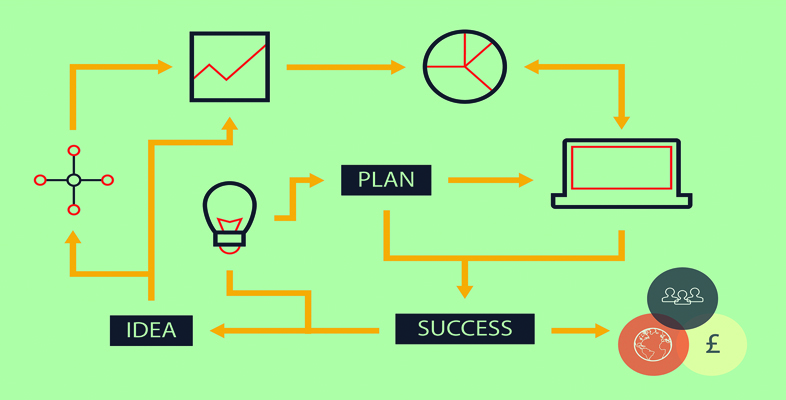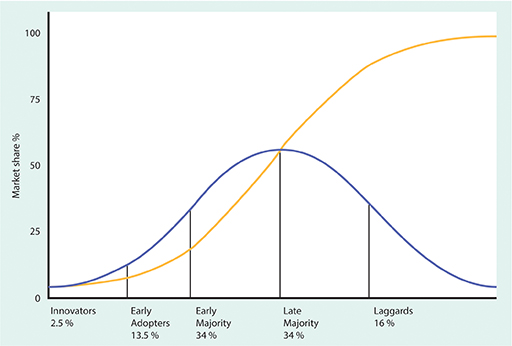2.2 What kind of market is it?
When discussing markets and opportunities, one useful way to consider these is that they have a lifecycle: they grow, mature and often they disappear. Each of these phases has a different character.
Lifecycle model
- Introduction: in this phase sales are small – often it is difficult to make any profit due to the costs of taking the offer to market
- Growth: this phase is when the market is growing rapidly, providing opportunities for profits, and when others may come into the market
- Maturity: at this point the increase in sales starts to tail away then plateau, profits are still present but competition may be intense
- Decline: this phase sees sales and profits decline.
This approach sets out the different conditions in the market at different stages, and suggests phases where competition and profit vary. It also asks you to consider questions around organisational strategy. Another way of looking at this is in relation to the Rogers (1962) technology adoption curve.
In the graph above, the blue bell-shaped curve shows the stage at which successive customer groups enter the market. The yellow steep rising curve shows the cumulative market share eventually resulting in saturation of the market. Rogers’ focus is on the consumer rather than the lifecycle of the product. Early adopters of technology are typically well educated with higher disposable income, which can be read as a prediction of which socio-economic groups might adopt new approaches first. Rogers (1962) also suggested you think of the phases of adoption in terms of how to move consumers along the curve from Awareness through Persuasion, to Trialling, then Adoption and Consolidation.
Activity 4 The product life cycle
Considering the product focus of the lifecycle model, think about the following questions. It might also be useful to ask the same questions of the technology adoption curve.
- How well does the lifecycle model apply to the market you are interested in?
- What does your intuition tell you about what phase the market might be in?
- How might you test your intuition?
Discussion
Perhaps you found the curves useful to reflect on the stage of product lifecycle and type of customers present. Has it provided you with some useful insights, even if only by considering questions you hadn’t asked before? Perhaps you recognise the need for more information. If so, secondary sources like industry reports or trade magazines might be useful.
If you found them less useful, you may have spotted problems with interpreting whether the market is in a growth phase or not. If sales are stable, how long will they remain so? Will sales go up or go down?
Another criticism of this approach is that it doesn’t account for fashion or fads. For example, how does it account for the resurgence of Vinyl records? At the time of writing these are enjoying booming sales.
Faddish products like the latest toy might grow rapidly and then crash, and technology companies offering a new software or hardware product may seek to rush straight past early adopters and go from margin to mainstream very quickly. Perhaps the phases themselves are not important, but what you can take from Rogers’ observation is the need to move on from early adopters through acts of persuasion to become mainstream, by moving beyond the usual suspects to activate latent demand. Or you recognise and are happy to operate in a niche!
There are several ways in which this section has provided a fairly traditional view of the market. Consider this question – do you think the market for your offer is out there already or does your offer create an entirely new one? In the vast majority of cases, unless your offer is something akin to the iPad, you will be competing in an existing market. So what kind of market is it? How will you compete? You will look at this next.

